-
Crisis Mapping 2009 – The First International Conference on Crisis Mapping: Oct 16-18 in Cleveland
All posts by Stefan Geens
links for 2009-09-30
-
DIY automated Street View setup with off-the-shelf components:
Qum nuclear site redux: Original-resolution images now published to Google Earth
Earlier today I asked ISIS if I could overlay in Google Earth the high-resolution original of the GeoEye image taken on September 26 showing what is likely the underground nuclear fuel processing plant being built near Qum in Iran. Soon after, my inbox brimmed not just with the original image file from September 26, but also with the DigitalGlobe image from January 2009. (See previous Ogle Earth story for context.)
The September 26 GeoEye image is a massive 6,000×6,000 pixel tile covering 9 square kilometers at 50cm per pixel. The January 2009 DigitalGlobe image clocks in at almost 4,000×4,000 pixels and 60cm per pixel. They’ve now been overlaid in Google Earth and are available as a 11MB KMZ file.
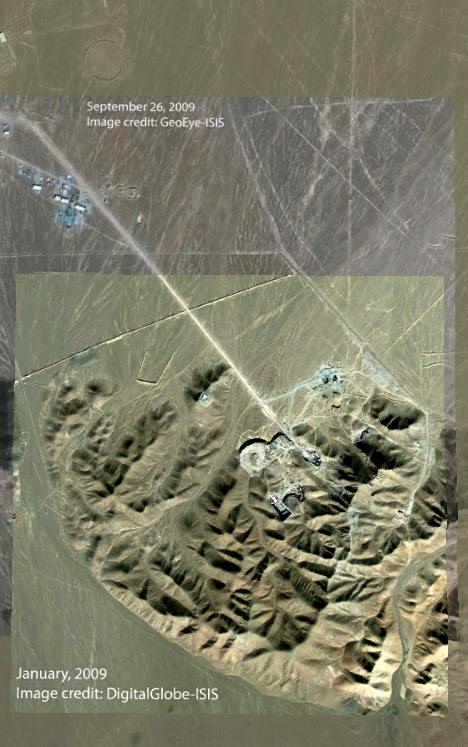
The images haven’t been orthorectified, so I’ve aligned them as much as possible on the flat features of the plain. This means that higher ground diverges between the two images and Google Earth’s base image (from March 25, 2005).
With these original-resolution versions, there is much delicious detail to explore — vents, depots, trails, towers, and a whole new hamlet to boot. Go crazy:-) (Remember, the opacity slider in the sidebar is your friend. Select the layer in the sidebar, and start sliding.)
Perhaps this is also a good moment to step back in awe at what modern technology has wrought — the ability for any sufficiently concerned citizen or organization to scrutinize any desired spot on Earth within hours of making the request, and then being able to publish the result to a context-rich virtual globe that is universally available. That’s a profound shift in favor of accountability, transparency and democracy. Monitoring the planet has been crowdsourced.
Case in point: In response to my throw-away line in the last post about how “intelligence services are right now trying to calculate the volume of the excavated mound … to estimate the minimum size of the excavated space”, “Blowback” pointed me to a comment thread on the very public Arms Control Wonk site where this calculation has already been tackled. Blowback’s own contribution is resplendent with the kind of geeky detail that I can only marvel at, so here it is in full, with permission:
Looking at the early spoil heap (2005), the area of the top is ~9,500 sqm while the area of the bottom is ~14,500 sqm. Assuming a 45deg slope, the maximum depth (at northern tip) is ~14m while the minimum depth (southern edge) is 4m. Simplifying this gives an average area of 12,000 sqm and a average depth of 9m so the volume of the early spoil heap is ~110,000 cubic metres. I would guess that the new pile is about 4 times the early pile, so the total volume would be 550,000 cubic metres. With your expansion factor of 1.4, that means the tunnel volume is ~400,000 cubic metres. For reference, the two huts are about 1000 sqm each.
It is most likely that the underground structure consists of a roadway and a large chamber(s). If we assume that the first excavation was a roadway to reach the chamber and they were using say Terex TA40 articulated tippers, then the roadway would need to be 6m high by 10m wide giving a spoil volume of 60 cubic metres per linear metre, so the spoil volume of 110,000 which equates to a solid rock volume of 78,000 cubic metres translates to a roadway length of 1300 metres. As for the chamber, the volume of spoil is ~440,000 cubic metres which would result from ~320,000 cubic metres of solid rock. So at a height of 6m, this would give a floor area of over 50,000 sqm. Quite big!
Blowback, who has a civil engineering background, explains some of his assumptions:
The expansion factor is to allow for the increase in volume that occurs when you dig rock out of the ground. The size of the roadway is determined by twice the size of the tipper truck used to haul muck out of the tunnel – you want two trucks to be able to pass each other at any point in the tunnel otherwise you radically slow the tunnelling rate. I picked the Terax TA40 because that is typical of the tipper trucks used in driving roadways in tunnelling – too small a truck and it takes too long, too large a truck and you have to haul too much muck. There is a lot of estimation in my rough calculations but the results are probably right in terms of order of magnitude so when I say the access tunnel length is 1300 metres, then the probability that it is between 1 and 2 km is high, but it is pretty unlikely to be 10kms and very unlikely to be 20kms. If you spot any mistakes in my calculations, please let me know.
How did I ever survive before the Internet?
Adding the time-dimension to panoramas
It’s been quiet here on Ogle Earth (unless there is a neogeopolitical emergency to tend to) because the past month has been crunch time to get a new site out the door: The website of the Swedish Pavilion at Shanghai Expo 2010, or at least v1.0 of it, which launches today.
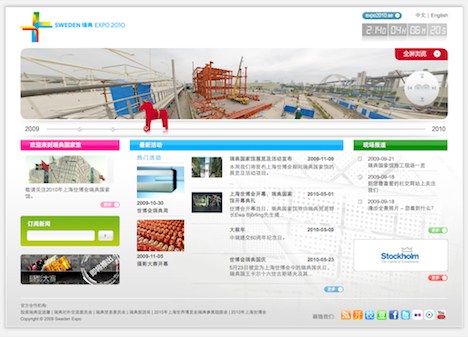
The site’s got lots of bright colors and the default page is in Chinese, because it is aimed shamelessly at the almost 400 million Chinese who have gone online, around 90% of whom have never been on an English language site. (Don’t worry, almost all of the site is also available in English.)
The website is not about neogeography, but it is very much about a specific place and time. I can justify plugging it here on Ogle Earth because it also comes with an interesting proof of concept about recreating a sense of place that perhaps one day we’ll see in Street View: A time-series of panoramas taken from the exact same location — in our case, right next to the Swedish pavilion, as it is being built. (Find it on the home page, and go straight for the full-screen view. Move the red Dalecarlian horse to and fro to see progress in the construction.)
Just as Google Earth’s satellite imagery became immensely more useful when the addition of historical imagery gave us the time dimension to play with, so too Street View would benefit when in a few years’ time multiple passes will have been made of the same roads. One challenge with such panoramas: Finding the exact same vantage point, so you can maintain the illusion of moving in time without moving perspective. That will likely not be easy to scale, considering that Street View cars can’t always choose their lane and that GPS is not that accurate.
But three years from now, I’d be surprised if we didn’t have viable 3D urban reconstructions from point clouds generated automatically out of successive Street Views. (Previously blogged proofs of concept include EarthMine and Photosynth.) In that kind of environment, the precise locations of panoramas in successive passes are no longer important, as the contents will all be mapped to a common evolving 3D surface anyway. Moving the time slider will let you see how the cityscape evolves, with both surface imagery and volumes progressing over time.
It’s something of a pity that such technology will arrive about a decade too late to document the immense pace of change here in Shanghai as neighborhoods are converted wholesale from row houses to skyscrapers.
But at least we’ve got the Swedish pavilion covered:-)
Related: I’ve previously written up my working notes on the different ways of marketing a place online (and the comments are worth reading too). I still need to implement many of these. One thing I think will be worth investigating is to see if it is possible to use the timeline feature Google Earth with a time-series of spherical panoramas as rendered in KML. But that’s a project for things get a little less crazy around here.
Unrelated but interesting: Notice how there is no way to comment on swedenexpo.cn? That’s because if you want a license to operate a website in China with user-generated content, you also have to hire a censor, and that is not politically possible for us (not to mention undesirable). We’ve found a solution, however — outsourcing the commenting (and censoring) to a slew of popular Chinese social networking sites. For those of you outside the Great Chinese Firewall (or with a VPN) There is the Facebook fan page and the Twitter feed.
Further examples: There are two other examples I’ve been made aware of where panoramas are linked together in a time series: A demo by Hans Nyberg and one of a spot on the Belgian coast. Any further examples are welcome.
links for 2009-09-27
-
Google patent application for using panoramic images in driving directions (thanks Mike!)
Updated: Iran nuclear site candidate satellite images from 2009, now overlaid in Google Earth
During the North American day yesterday ISIS chimed in with its best guess (PDF) for where Iran’s newly declared underground nuclear fuel enrichment plant is situated — two guesses, in fact.
One of them is the same as the location identified in the previous post here on Ogle Earth as a likely candidate for the site. But ISIS also identifies another possible location further to the east.
ISIS has the benefit of very recent imagery it commissioned, taken by DigitalGlobe — August 2009 for the already-identified candidate, and January 2009 for the new candidate. The new candidate in particular shows much development work in the intervening four years between when the base imagery in Google Earth was taken and the DigitalGlobe imagery acquired in 2009.
2009:
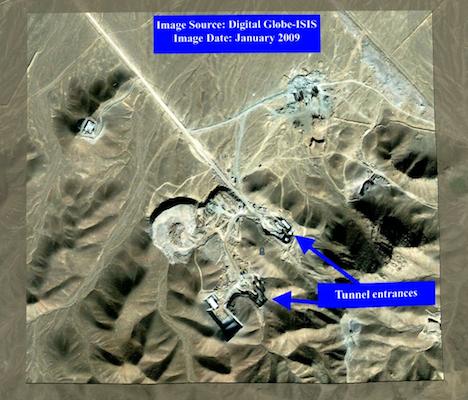
2005:
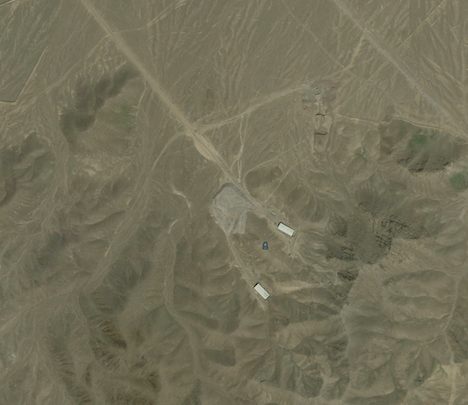
The other candidate, to the west, shows little outward change in the intervening four years. Based on the 2009 imagery, my inexpert opinion now favors the new candidate identified by ISIS.
ISIS’s findings are in PDF format, so I took the images therein and positioned them as overlays in Google Earth. Here they are available as a KMZ download. Play with the opacity slider in the sidebar to switch between 2009 and 2005.
[Update 18:01 UTC 2009-09-28: ISIS has now also published a brand new image of the site pictured above, commissioned from GeoEye on September 26 2009. The KMZ file linked to above has been updated to include this second image. The resolution is a bit lower than the DigitalGlobe image taken in January 2009, but there is clear progress visible in the construction site during the intervening 8 months — both tunnel entrances are now being covered up with earth. I suspect intelligence services are right now trying to calculate the volume of the excavated mound right in front of the tunnels as a way of estimating the minimum size of the excavated space inside the mountain.]
[Update 11:42 UTC 2009-09-29: KMZ file is now updated with two closeups from the Sept 26 GeoEye image, via this CNET article, attributing IHS Jane’s analysis.]
[Update 2009-09-39: New post: Qum nuclear site redux: Original-resolution images now published to Google Earth]
(Note: Because the imagery is of hilly terrain and taken from a different position in the sky, it is not perfectly alignable with the base imagery.)
Hunting for Iran’s secret nuclear plant near Qum on Google Earth
(Read an update to this post, featuring imagery from 2009)
Iran’s nuclear program is again making the news cycles after the country admitted this week that it has built a second nuclear fuel processing plant, to complement the one at Natanz.
According to the New York Times, the admission by Iran came after it learned that western intelligence agencies knew of its existence, and indeed the US, UK and French leaders were just now on TV to accuse Iran of having concealed the plant from the International Atomic Energy Agency (IAEA) for all the years it was under construction.
The New York Times has US government sources situating the new plant “inside a mountain near the ancient city of Qum,” and that alas is the most detail we can glean right now from public news sources.
Might it be enough to find this new plant in Google Earth, however? Not with certainty, but one place in particular looks like a very strong candidate. I’ll explain how I found it, you decide how likely it is to be the right place.
First, I turned on successive years of the “Digital Globe Coverage” layer in the “More” directory in the “Layers” sidebar of Google Earth, and went exploring around Qum (aka Qom).
The working assumption is that any satellite image tile taken all by itself as a “special request”, instead of as part of a long strip, tends to be taken at the behest of an organization that has good cause to investigate that region for something it might not have direct access to. This need not be an intelligence agency, it could also be an NGO, for example one that is interested in proliferation issues like ISIS:
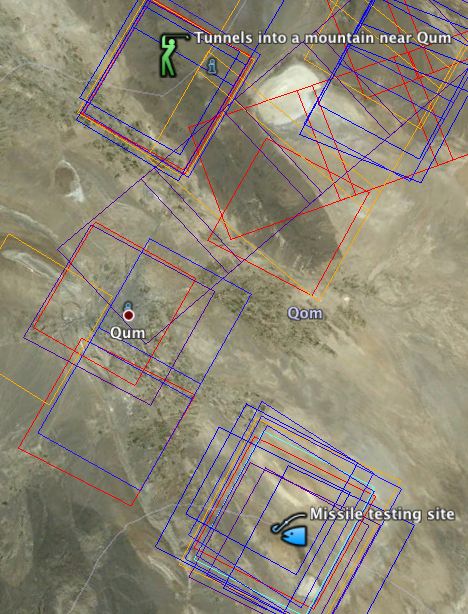
With this search criteria in mind, two areas around Qum are found to be consistently the beneficiaries of such special requests. One of them is an Iranian missile test site some 40km ESE of Qum, and it is not near a mountain. The other one?
Well, it’s a mountain 35km NNW of Qum. And it has two big parallel roads driving straight into it:
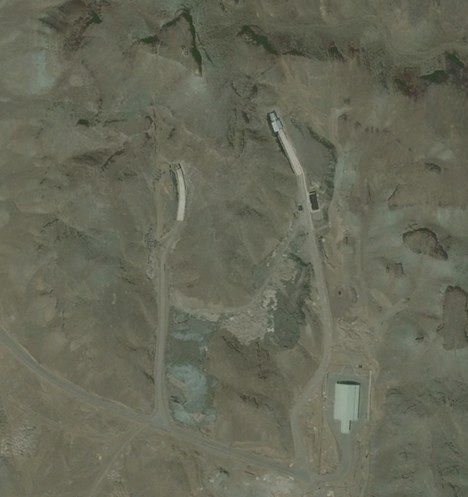
Considering that one-ended tunnels are rare finds, and after a look around Qum to see if there might be other overlooked sites, this candidate site sure looks promising.
Here is the placemark for the location, with a bonus pointer to the missile testing site. Enjoy.
(One weird additional piece of information: The imagery all the way around the mountain is dated August 21, 2005, but the area immediately around the entrance of the tunnel comes with no date attached in Google Earth. Imagery metadata in Google Earth is almost never that granular. The imagery of the tunnels could be newer, as 2005 would be a long way back to be building this plant (though not the tunnel for the plant), but there is no clear seam of a more recent image being overlaid on a base image. So my guess is that the imagery of the tunnel is from 2005 or later.)